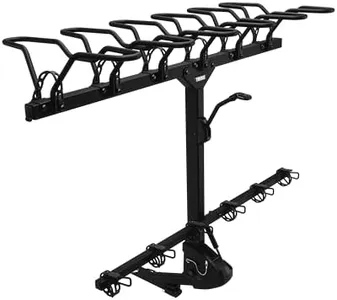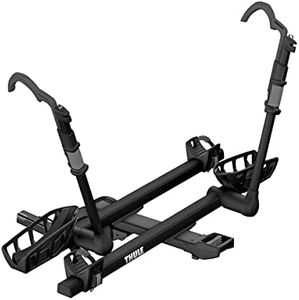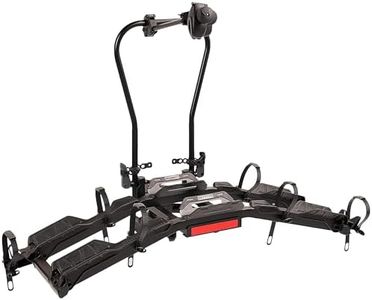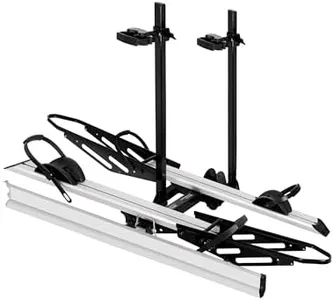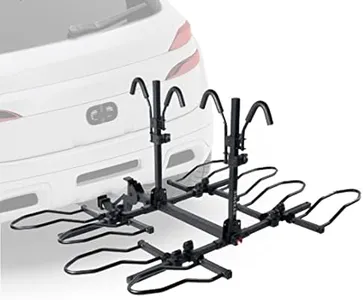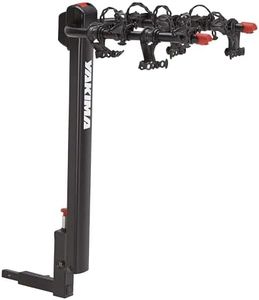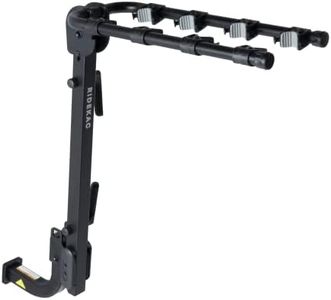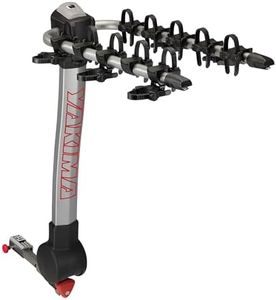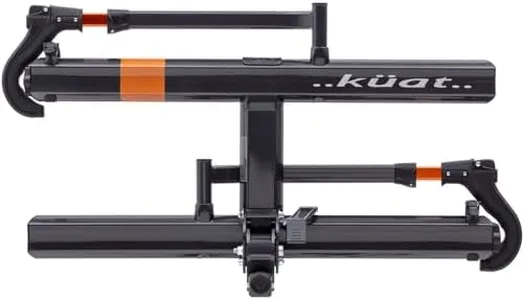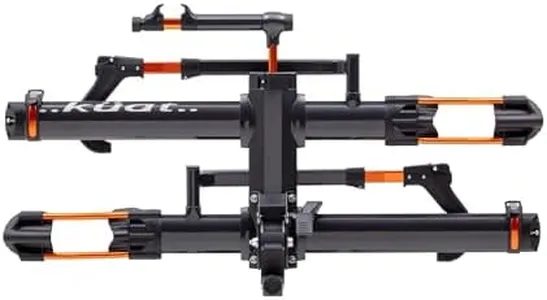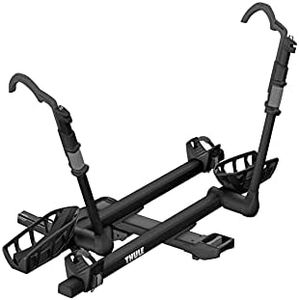10 Best Mountain Bike Racks 2025 in the United States
Our technology thoroughly searches through the online shopping world, reviewing hundreds of sites. We then process and analyze this information, updating in real-time to bring you the latest top-rated products. This way, you always get the best and most current options available.

Our Top Picks
Winner
Thule Revert Vertical Hitch Rack, 4 Bikes, Carrier for Trucks and Vans, Assisted Lift and Lower, e-Bike Compatible, no Frame or Fork Contact
Most important from
34 reviews
The Thule Revert is a vertical hitch bike rack designed for trucks and vans, capable of carrying up to four bikes with a high weight capacity of 55 lbs (25 kg) per bike. This makes it ideal for heavy mountain bikes, including e-bikes. One of its standout features is the assisted lift and lower mechanism, thanks to a hydraulic damper, which reduces the effort needed to load and unload bikes—great if you want minimal lifting. Its wheel baskets support tires up to 5 inches wide, covering most mountain bike wheel sizes, although smaller wheel inserts are sold separately. The rack's clever tilt design allows access to the vehicle trunk even when bikes are mounted, improving convenience. Security is enhanced by the rack locking itself when tilted down for loading, and it includes a memory function to help raise the rack back up smoothly.
In terms of installation, it mounts universally on a hitch, but it is not foldable, which may affect storage when not in use. The rack is sturdy and durable, weighing about 33 kg (72 lbs), reflecting its robust build but might be heavy for some users to handle alone during installation. For those who frequently transport heavy mountain or e-bikes and want an easier loading experience with secure and stable carrying, the Thule Revert presents a strong option. However, its weight and lack of foldability might be less convenient for those with limited storage space or who prefer lighter racks.
Most important from
34 reviews
T2 Pro XTR 2 Bike (2 in) Black
Most important from
1059 reviews
The Thule Pro XTR 2 Hitch Bike Rack has several strong points making it a solid choice for mountain bikers and e-bike owners. Its versatile design accommodates various bike styles up to 60 lbs each, including carbon frames, mountain, downhill, and fat bikes without needing adapters. The no-frame-contact feature ensures that your bike's paint and frame integrity are maintained during transport. It also includes integrated wheels, which are handy for maneuvering the rack when it's off the vehicle.
The HitchSwitch lever allows for easy tilting for trunk access or for compact storage when not in use. The generous spacing and adjustable side-to-side positioning minimize bike interference, making it easier to secure multiple bikes without damage. Its fully locking system, including integrated cable locks and locking knob, adds a layer of security, ensuring your bikes and the rack remain safe during transit and while parked.
The AutoAttach system offers tool-free installation and removal, making it user-friendly even for individuals not skilled in bike rack assembly. Additionally, it has a robust load capacity of 120 lbs and can support up to 4 bikes with a Thule add-on (sold separately). However, the rack's weight might be a drawback, with the package weighing around 28.58 kilograms, which could be cumbersome for some users. Despite this, the durable construction and limited lifetime warranty provide peace of mind regarding its longevity and reliability. The Thule Pro XTR 2 is a well-rounded bike rack with thoughtful features, but potential buyers should consider its weight during handling and installation.
Most important from
1059 reviews
Yakima 4-Bike Hitch Mount Carrier, Swing-Away Bike Rack for Car, Truck, & SUV, FullSwing 4 - Heavy-Duty Bicycle Storage Equipment and Accessories for Vehicles
Most important from
450 reviews
The Yakima 4-Bike Hitch Mount Carrier is a heavy-duty bike rack designed for cars, trucks, and SUVs with a 2-inch hitch receiver. It features a swing-away design that allows easy access to the vehicle’s rear without removing the rack, even when fully loaded. This is especially useful for reaching the trunk or backseat. The rack can hold up to 4 bikes, supporting a total weight of 150 to 160 pounds, accommodating most mountain and road bikes comfortably.
Installation is simple and tool-free, using a locking SpeedKnob and AutoPin system that securely attaches the rack to the vehicle in minutes. Padded arms and ZipStrips protect bikes from scratches and keep them stable during transport, helping preserve each bike’s condition. The rack fits a wide variety of bike frames and sizes, making it versatile for mixed bike collections. While sturdy and built to last, it weighs around 38 kilograms (about 83 lbs), which may require some effort when handling alone.
Security features include built-in locks that secure both the rack to the vehicle and the bikes to the rack, helping prevent theft. The rack also folds down compactly when not in use, saving space. For those needing a reliable and durable bike rack capable of transporting multiple mountain bikes while providing easy rear vehicle access, this Yakima model is a solid choice. Its higher weight and size might require some effort during handling, but its ease of installation and strong bike protection make it a practical and user-friendly option.
Most important from
450 reviews
Buying Guide for the Best Mountain Bike Racks
Choosing the right mountain bike rack is essential for safely transporting your bike to various trails and locations. The right rack will ensure your bike is secure, easy to load and unload, and compatible with your vehicle. To make an informed decision, consider the following key specifications and how they align with your needs.FAQ
Most Popular Categories Right Now


